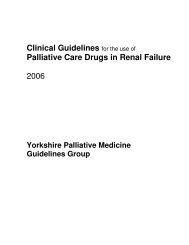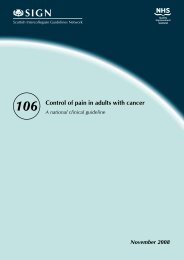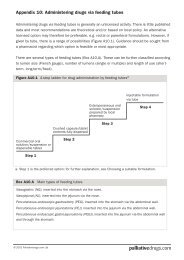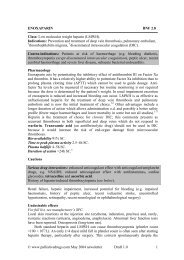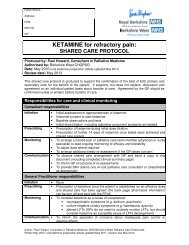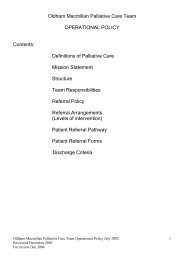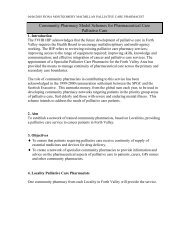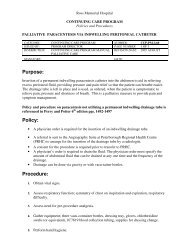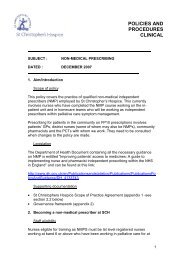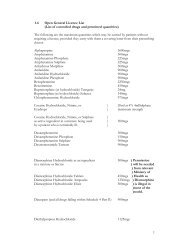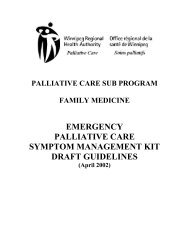Guidelines for the Management of Malignant Ascites
Guidelines for the Management of Malignant Ascites
Guidelines for the Management of Malignant Ascites
You also want an ePaper? Increase the reach of your titles
YUMPU automatically turns print PDFs into web optimized ePapers that Google loves.
SAINT FRANCIS HOSPICE<br />
POLICY/PROCEDURE:<br />
ASCITES<br />
Department: Clinical Originator: Dr Corinna Midgley<br />
Applicable to:<br />
Clinical Team<br />
Purpose <strong>of</strong> <strong>the</strong> document:<br />
To clarify safe procedure around paracentesis<br />
and use <strong>of</strong> diuretics<br />
Who was consulted:<br />
Dr Nia Ellis<br />
Sue Waite<br />
Sue Lakey<br />
Approved by:<br />
Date first<br />
produced: 06.10.2003<br />
Date last<br />
amended:<br />
Date last<br />
reviewed: Review date: 06.10.2006<br />
Circulation list – to receive revisions<br />
Inpatient Unit<br />
Community Services<br />
Day Hospice<br />
Education Centre<br />
C:\___From Windows98___\AndrewW\My Documents\web files\<strong>Ascites</strong>JointPolicySFH.doc
<strong>Guidelines</strong> <strong>for</strong> <strong>the</strong> <strong>Management</strong> <strong>of</strong> <strong>Malignant</strong> <strong>Ascites</strong>.<br />
Treatment <strong>of</strong> accumulated fluid should be minimally invasive, should not add to <strong>the</strong> patient’s<br />
burden and should be aimed at relieving symptoms.<br />
Diuretics<br />
• May be a helpful initial treatment when <strong>the</strong> abdomen is not tense and paracentesis is not<br />
immediately indicated <strong>for</strong> symptom relief. The aim, in this situation, is to reduce <strong>the</strong> volume<br />
<strong>of</strong> ascites so that <strong>the</strong> patient can avoid need <strong>for</strong> drainage.<br />
• More commonly <strong>the</strong> patient presents with a tense abdomen which needs drainage and/or o<strong>the</strong>r<br />
definitive management (such as analgesia). Diuretics should in this case be trialled after<br />
definitive procedures, if <strong>the</strong> patient is well enough. The aim being to slow or prevent<br />
reaccumulation <strong>of</strong> ascitic fluid.<br />
Spironolactone is <strong>the</strong> diuretic <strong>of</strong> choice.<br />
1. Baseline urea and electrolytes<br />
2. Spironolactone starting dose 100-200mg mane<br />
3. Dose increase by 100mg every 3-7 days (Maximum response after 2-3 days).<br />
Usual maintenance 300mg mane<br />
Maximum<br />
400mg mane<br />
‘Success’<br />
measured by relief <strong>of</strong> symptoms (or weight loss, in hospital)<br />
If no change in symptoms with spironolactone <strong>the</strong>n consider addition <strong>of</strong> furosemide 40mg mane 1 .<br />
If responsive, substantial reduction in ascites may take 10-28 days.<br />
Some patients may be too frail to tolerate large doses and care should be taken if <strong>the</strong>re is<br />
significant renal impairment.<br />
Side effects may include hypotension and electrolyte disturbance, especially risk <strong>of</strong><br />
hyperkalaemia. If <strong>the</strong>re is any clinical concern that <strong>the</strong>re might be biochemical disturbance U and<br />
E’s should be measured.<br />
If <strong>the</strong>re is deterioration in renal function, diuretics should be stopped.<br />
See BNF <strong>for</strong> specific interactions with drugs such as NSAIDS and digoxin.<br />
Response is unpredictable. Only in cirrhotic-type ascites (or large liver metastases) is <strong>the</strong>re<br />
evidence <strong>of</strong> effectiveness; diuretics in this situation may be very helpful.<br />
However we <strong>of</strong>ten do try <strong>the</strong>m in ascites with o<strong>the</strong>r than large liver metastases, particularly when<br />
patients are too frail to undergo any o<strong>the</strong>r intervention.<br />
If consensus is that diuretics have not reduced <strong>the</strong> rate <strong>of</strong> reaccumulation <strong>of</strong> ascites, nor <strong>the</strong><br />
volume accumulating, <strong>the</strong>n <strong>the</strong>y should be stopped.<br />
Paracentesis<br />
This is <strong>the</strong> drainage <strong>of</strong> ascitic fluid via a ca<strong>the</strong>ter inserted through <strong>the</strong> abdominal wall. Symptoms<br />
improve in about 90% <strong>of</strong> cases though <strong>the</strong> ascites may reaccumulate rapidly. Unnecessary<br />
investigations should be avoided and drains should be left in <strong>for</strong> only a short time.<br />
The guiding principle is one <strong>of</strong> minimal disturbance.<br />
1 In studies comparing spironolactone with loop diuretics such as furosemide, treatment with even very<br />
large oral doses <strong>of</strong> furosemide (>200mg) generally failed to relieve ascites. Whereas spironolactone in a<br />
median daily dose <strong>of</strong> 300mg significantly reduced ascites in about 2/3 <strong>of</strong> patients. (PCF 1998).<br />
C:\___From Windows98___\AndrewW\My Documents\web files\<strong>Ascites</strong>JointPolicySFH.doc 1
Paracentesis Kit:<br />
• Suprapubic ca<strong>the</strong>ter<br />
• 10ml syringe x 2<br />
• Blue needle<br />
• Green needle x 2<br />
• Dressing pack<br />
• Gauze pack x 2 (10 x 10cm)<br />
• Scalpel (straight blade)<br />
• Wound pads x 2<br />
• Sleek<br />
• Ca<strong>the</strong>ter bag (normal)<br />
• Scissors<br />
C:\___From Windows98___\AndrewW\My Documents\web files\<strong>Ascites</strong>JointPolicySFH.doc 2
<strong>Guidelines</strong> <strong>for</strong> Paracentesis<br />
In advance:<br />
1. Give appropriate explanation and ascertain whe<strong>the</strong>r <strong>the</strong> patient has any strong expectations<br />
about <strong>the</strong> procedure, hydration or resuscitation in <strong>the</strong> event <strong>of</strong> complications.<br />
2. If <strong>the</strong>re is evidence <strong>of</strong> substantial ascites in <strong>the</strong> <strong>for</strong>m <strong>of</strong> a tense abdomen and fluid thrill it is<br />
usually safe to proceed with drainage without USS imaging.<br />
3. Ultrasound evaluation with or without marking <strong>of</strong> <strong>the</strong> drainage point may be required in cases<br />
<strong>of</strong> diagnostic uncertainty or suspected loculation <strong>of</strong> ascites.<br />
4. If <strong>the</strong>re is ascites clinically, or it is radiologically confirmed but <strong>the</strong> abdomen is not tense and<br />
<strong>the</strong>re is no fluid thrill consider deferring <strong>the</strong> procedure as benefit will be limited. What is <strong>the</strong><br />
aetiology <strong>of</strong> this ascites? Particularly in <strong>the</strong> case <strong>of</strong> portal hypertension, secondary to e.g.<br />
massive liver metastases, have diuretics been tried?<br />
5. If <strong>the</strong> patient is frail, consider whe<strong>the</strong>r paracentesis is appropriate or whe<strong>the</strong>r alternative<br />
symptom control measures are to be preferred, e.g., analgesics <strong>for</strong> abdominal discom<strong>for</strong>t,<br />
metoclopramide and antacids <strong>for</strong> ‘squashed stomach’ symptoms.<br />
6. Intravenous fluids are not routinely required.<br />
Per<strong>for</strong>ming <strong>the</strong> procedure:<br />
7. A baseline pulse and blood pressure measurement should always be recorded as it will help<br />
in<strong>for</strong>m drainage rate. If hypotensive (systolic 100mmHg), and previous procedures<br />
have been well tolerated <strong>the</strong> drain should be left to drain freely, up to 5L.<br />
• If less than 5L drains <strong>the</strong>n <strong>the</strong> rate slows considerably or stops, <strong>the</strong> drain should be removed.<br />
• If 5L drains <strong>the</strong> drain should be clamped <strong>for</strong> 6 hours be<strong>for</strong>e drainage resumes. (It may be<br />
more appropriate/less disruptive <strong>for</strong> <strong>the</strong> patient <strong>for</strong> <strong>the</strong> drain to be clamped overnight).<br />
• A repeat BP and pulse measurement should be recorded again be<strong>for</strong>e free drainage resumes.<br />
If systolic BP remains>100mmHg <strong>the</strong>n free drainage can be resumed, again up to 5L a/a, or<br />
to stop as described above.<br />
• These steps can be repeated as needed until <strong>the</strong> drainage rate slows considerably or stops. The<br />
drain should <strong>the</strong>n be removed.<br />
Most patients will be free <strong>of</strong> <strong>the</strong>ir drain after 24 hours.<br />
C:\___From Windows98___\AndrewW\My Documents\web files\<strong>Ascites</strong>JointPolicySFH.doc 3
Exceptions:<br />
• If hypotensive prior to <strong>the</strong> procedure or after drainage resumption <strong>the</strong>y should be drained<br />
more slowly, at a rate <strong>of</strong> no more than 1 litre per hour, initially, and up to 3 litres in <strong>the</strong> first 6<br />
hours, and in subsequent 6 hour spells. BP should be recorded prior to resumption <strong>of</strong> drainage<br />
spells.<br />
When drainage rate slows considerably or stops <strong>the</strong> drain should be removed.<br />
♦ If <strong>the</strong> patient feels dizzy during drainage <strong>the</strong> drain should be clamped and pulse and BP<br />
recorded. If hypotensive <strong>the</strong> rate <strong>of</strong> drainage should slow, as above, ■.<br />
When drainage rate slows considerably or stops <strong>the</strong> drain should be removed.<br />
Most patients will tolerate <strong>the</strong> procedure well. The patients most vulnerable to symptomatic<br />
hypotension (hypovolaemia) are those with ascites arising secondary to portal hypertension. In<br />
patients with massive liver metastases, hepatocellular carcinoma +/- cirrhosis, or venous outflow<br />
obstruction <strong>the</strong> risk <strong>of</strong> hypovolaemia is higher. Hence <strong>the</strong> importance <strong>of</strong> asking <strong>the</strong> patient to<br />
report symptoms <strong>of</strong> dizziness, and BP monitoring- <strong>of</strong> all patients, but especially <strong>the</strong>se patients!<br />
The patient may well need prn medication <strong>for</strong> breakthrough abdominal ache or soreness at <strong>the</strong><br />
drain site and prn medication should always be available.<br />
Escalating pain, not controlled by prn medication, requires medical review 2 .<br />
Aftercare:<br />
13. If <strong>the</strong>re is minimal leakage from <strong>the</strong> puncture site after <strong>the</strong> drain is removed, apply a dressing<br />
pad. If <strong>the</strong>re is significant leakage, apply a stoma bag over <strong>the</strong> site until it becomes minimal<br />
and <strong>the</strong>n apply a dressing pad. (Sometimes patients need a stoma pack over <strong>the</strong> site <strong>for</strong><br />
several days).<br />
14. Patients <strong>of</strong>ten feel ‘washed out’ and weak during and in <strong>the</strong> last few hours after <strong>the</strong><br />
procedure. Usually rest and reassurance (and analgesia if <strong>the</strong>re is discom<strong>for</strong>t) are sufficient. If<br />
<strong>the</strong>re is greater cause <strong>for</strong> concern, check blood pressure, assess need <strong>for</strong> intravenous fluids<br />
and consider o<strong>the</strong>r complications <strong>of</strong> paracentesis, but remember that it may not always be<br />
appropriate to resuscitate or treat complications.<br />
15. Analgesic requirement after drainage may well be different from that needed pre drainage.<br />
Sometimes removal <strong>of</strong> <strong>the</strong> fluid will lead to increased baseline com<strong>for</strong>t and a need to reduce<br />
analgesia. Sometimes it will lead to increased baseline discom<strong>for</strong>t and a need to increase<br />
regular analgesia. The patient’s com<strong>for</strong>t needs to be revisited, whe<strong>the</strong>r in <strong>the</strong> hospital/hospice<br />
or at home over <strong>the</strong> next few days, with availability, in whatever setting, <strong>of</strong> prn medication.<br />
References:<br />
Stephenson J, Gilbert J. The development <strong>of</strong> clinical guidelines on paracentesis <strong>for</strong> ascites related to<br />
malignancy. Pal Med 2002; 16: 2113-218<br />
Campbell C. Controlling malignant ascites. EJP, 2001; 8(5): 187-190<br />
2 Rare adverse effects include:<br />
• hypovolaemia (0-3%),<br />
• haemorrhage (1-2% risk <strong>of</strong> serious haemorrhage into <strong>the</strong> peritoneal cavity or abdominal wall)<br />
• pulmonary emboli, occasionally reported and arising from dislodged thromboses in large intraabdominal<br />
veins<br />
• peritonitis, which may arise from intestinal per<strong>for</strong>ation or prolonged placement <strong>of</strong> <strong>the</strong> ca<strong>the</strong>ter<br />
C:\___From Windows98___\AndrewW\My Documents\web files\<strong>Ascites</strong>JointPolicySFH.doc 4



